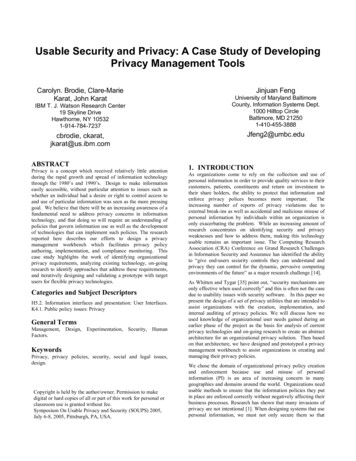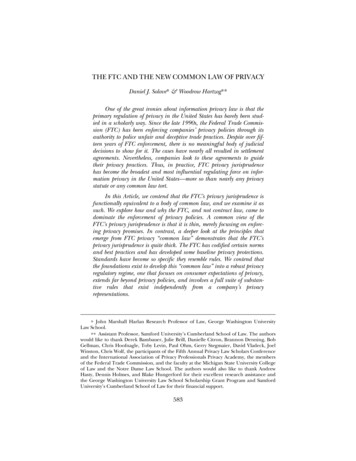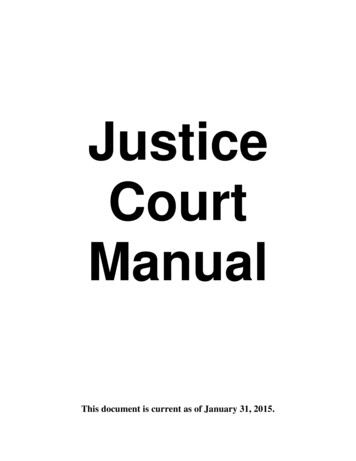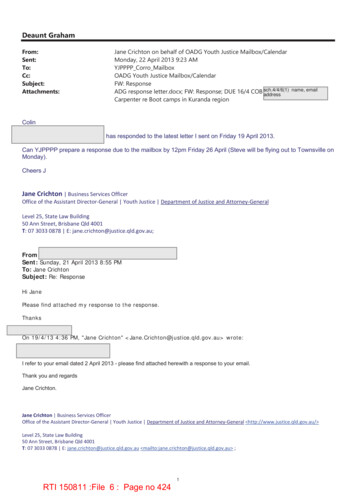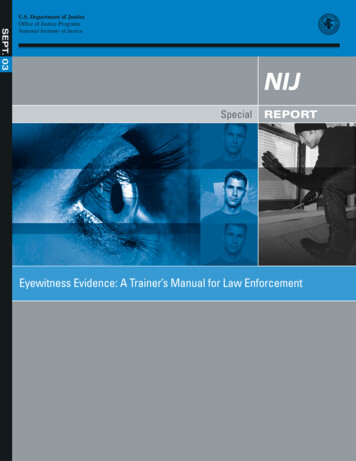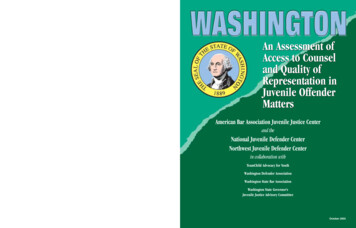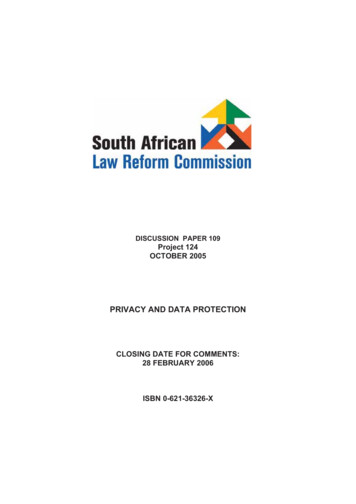
Transcription
DISCUSSION PAPER 109Project 124OCTOBER 2005PRIVACY AND DATA PROTECTIONCLOSING DATE FOR COMMENTS:28 FEBRUARY 2006ISBN 0-621-36326-X
ii INTRODUCTIONThe South African Law Reform Commission was established by the South African Law CommissionAct, 1973 (Act 19 of 1973).The members of the Commission are The Honourable Madam Justice Y Mokgoro (Chairperson)The Honourable Madam Justice L Mailula (Vice-Chairperson)Adv J J Gauntlett SCThe Honourable Mr Justice C T HowieProf I P Maithufi (full-time member)Ms Z SeedatThe Honourable Mr Justice W L SeritiThe Secretary is Mr W Henegan. The Commission's offices are on the 12th floor, Sanlam Centrec/o Pretorius and Schoeman Streets, Pretoria. Correspondence should be addressed to:The SecretarySouth African Law Reform CommissionPrivate Bag X668PRETORIA : index.htmThe members of the Project Committee for this investigation are:The Honourable Mr Justice CT HowieProf J NeethlingProf I CurrieMs C da SilvaMs C DuvalProf B GrantMs A GroblerMr M HeyinkMs S JagwanthMs A TilleyThe Chairperson is Mr Justice CT Howie, the Project Leader is Prof J Neethling and the researcheris Ms Ananda Louw.
iii PREFACEThis discussion paper, which reflects information accumulated up to the end of August 2005, hasbeen prepared to provide background information, to elicit responses from key parties and to serveas a basis for the Commission s deliberations.The views, conclusions and proposals in this paper are not to be regarded as the Commission sfinal views. The paper (which includes draft legislation) is published in full so as to provide personsand bodies wishing to comment or to make suggestions for the reform of this particular branch ofthe law with sufficient background information to enable them to place focussed submissionsbefore the Commission. A summary of recommendations submitted for comment appears on page(vi). The proposed draft legislation is contained in Annexure B.The Commission will assume that respondents agree to the Commission quoting from or referring tocomments and attributing comments to respondents, unless representations are markedconfidential. Respondents should be aware that under sec 32 of the Constitution of the Republic ofSouth Africa,1996 and under the Promotion of Access to Information Act2 of 2000theCommission may have to release information contained in representations.Respondents are requested to submit written comments, representations or requests to theCommission by 28 February 2006 at the address appearing on the previous page. Comment maybe sent by e-mail or post.The Discussion Paper is also available on the Internet at www.doj.gov.za/salrc/index.htm.Any enquiries should be addressed to the Secretary of the Commission or the researcher allocatedto this project, Ananda Louw. Contact particulars appear on the previous page.
iv SUMMARY OF PRELIMINARY RECOMMENDATIONSPrivacy is a valuable aspect of personality. Data or information protection forms an element ofsafeguarding a person’s right to privacy. It provides for the legal protection of a person ininstances where his or her personal information is being collected, stored, used or communicatedby another person or institution.In South Africa the right to privacy is protected in terms of both our common law and in sec 14 ofthe Constitution. The recognition and protection of the right to privacy as a fundamental human rightin the Constitution provides an indication of its importance.The constitutional right to privacy is, like its common law counterpart, not an absolute right butmay be limited in terms of law of general application and has to be balanced with other rightsentrenched in the Constitution.In protecting a person’s personal information consideration should, therefore, also be given tocompeting interests such as the administering of national social programmes, maintaining law andorder, and protecting the rights, freedoms and interests of others, including the commercial interestsof industry sectors such as banking, insurance, direct marketing, health care, pharmaceuticals andtravel services. The task of balancing these opposing interests is a delicate one.Concern about information protection has increased worldwide since the 1960's as a result of theexpansion in the use of electronic commerce and the technological environment. The growth ofcentralised government and the rise of massive credit and insurance industries that manage vastcomputerised databases have turned the modest records of an insular society into a bazaar ofinformation available to nearly anyone at a price.Worldwide, the surveillance potential of powerful computer systems prompt demands for specificrules governing the collection and handling of personal information. The question is no longerwhether information can be obtained, but rather whether it should be obtained and, where it hasbeen obtained, how it should be used. A fundamental assumption underlying the answer to thesequestions is that if the collection of personal information is allowed by law, the fairness, integrityand effectiveness of such collection and use should also be protected.There are now well over thirty countries that have enacted information protection statutes atnational or federal level and the number of such countries is steadily growing. The investigation into
v the possible development of information privacy legislation for South Africa is therefore in line withinternational trends.Early on, it was, however, recognised that information privacy could not simply be regarded as adomestic policy problem. The increasing ease with which personal information could betransmitted outside the borders of the country of origin produced an interesting history ofinternational harmonisation efforts, and a concomitant effort to regulate transborder informationflows.Two crucial international instruments evolved:a)The Council of Europe’s 1981 Convention for the Protection of Individuals withregard to the Automatic Processing of Personal Data (CoE Convention); andb)the 1981 Organization for Economic Cooperation and Development’s (OECD)Guidelines Governing the Protection of Privacy and Transborder Data Flows ofPersonal Data.These two agreements have had a profound effect on the enactment of national laws around theworld, even outside the OECD member countries. They incorporate technologically neutralprinciples relating to the collection, retention and use of personal information.Although the expression of information protection in various declarations and laws varies, all requirethat personal information be dealt with according to specific principles known as the “Principles ofInformation Protection” which form the basis of both legislative regulation and self-regulatingcontrol.Some account should also be taken of the UN Guidelines as well as the initiative of theCommonwealth Law Ministers in this regard. In both instances countries are encouraged to enactlegislation that will accord personal information an appropriate measure of protection, and also tomake sure that such information is collected only for appropriate purposes and by appropriatemeans.In 1995, the European Union furthermore enacted the Data Protection Directive in order toharmonise member states’ laws in providing consistent levels of protection for citizens and ensuringthe free flow of personal data within the European Union. It imposed its own standard of protectionon any country within which personal data of European citizens might be processed. Articles 25 and
vi 26 of the Directive stipulate that personal data should only flow outside the boundaries of the Unionto countries that can guarantee an “adequate level of protection”.Privacy is therefore an important trade issue, as information privacy concerns can create a barrier tointernational trade. Considering the international trends and expectations, information privacy ordata legislation will ensure South Africa’s future participation in the information market, if it isregarded as providing “adequate” information protection by international standards.It should be noted that the promulgation of information protection legislation in South Africa willnecessarily result in amendments to other South African legislation, most notably the Promotion ofAccess to Information Act 2 of 2000, the Electronic Communications and Transactions Act 25 of2002 and the, still to be enacted, National Credit Bill [B18-2005]. All these Acts contain interimprovisions regarding information protection in South Africa.The preliminary recommendations of the Commission, as set out in the Bill accompanying thisdocument as Annexure B, can be summarised as follows: 1a)Privacy and information protection should be regulated by a general informationprotection statute, with or without sector specific statutes, which will besupplemented by codes of conduct for the various sectors and will be applicable toboth the public and private sector. Automatic and manual processing will be coveredand identifiable natural and juristic persons will be protected [Chapter 2, clauses 36].b)General principles of information protection should be developed and incorporated inthe legislation. The proposed Bill gives effect to eight core information protectionprinciples, namely processing limitation, purpose specification, further processinglimitation,information quality, openness, security safeguards, individualparticipation and accountability. Provision is made for exceptions to the informationprotection principles [Chapter 3, Part A, clauses 7-23]. Exemptions arefurthermore possible for specific sectors in applicable circumstances [Chapter 4,clauses 32-33]. Special provision has furthermore been made for the protection ofspecial (sensitive) personal information [Chapter 3, Part B, clauses 24-31].c)A statutory regulatory agency should be established. Provision has been made foran independent Information Protection Commission with a full-time InformationCommissioner to direct the work of the Commission [ Chapter 5, Part A, clauses34-46]. The Commission will be responsible for the implementation of both theProtection of Personal Information Act (see Annexure B) and the Promotion ofAccess to Information Act, 2000. Data subjects will be under an obligation to notify1References in brackets are to the applicable clauses, parts and chapters in the Protection of Personal Information Billset out in Annexure B to this Discussion Paper.
vii the Commission of any processing of personal information before they undertakesuch processing [Chapter 6, Part A, clauses 47-51] and provision has also beenmade for prior investigations to be conducted where the information being collectedwarrants a stricter regime [Chapter 6, Part B, clauses 52-53].d)Enforcement of the Bill will be through the Commission using as a first step a systemof notices where conciliation or mediation has not been successful. Failure to complywith the notices will be a criminal offence. The Commission may furthermore assista data subject in claiming compensation from a responsible party for any damagesuffered. Obstruction of the Commission’s work is regarded in a very serious lightand constitutes a criminal offence [Chapter 8, clauses 63-87 and Chapter 9,clauses 88-92].e)A flexible approach should be followed in which industries will develop their owncodes of conduct (in accordance with the principles set out in the legislation) whichwill be overseen by the regulatory agency. Codes of conduct for individual sectorsmay be drawn up for specific sectors on the initiative of the specific sector or of theCommission itself. This will include the possibility of making provision for anadjudicator to be responsible for the supervision of information protection activitiesin the sector. The Commission will, however, retain oversight authority. Althoughthe codes will accurately reflect the information protection principles as set out in theAct, it should furthermore assist in the practical application of the rules in a specificsector [Chapter 7, clauses 54-62].f)It is the Law Commission’s objective to ensure that the legislation provides anadequate level of information protection in terms of the EU Directive. In this regard aprovision has been included that prohibits the transfer of personal information tocountries that do not, themselves, ensure an adequate level of information protection[ Chapter 10, clause 94].The preliminary recommendations and draft legislation need to be debated thoroughly. TheCommission is seeking feedback regarding all its proposals as set out in the proposed draft Bill.Respondents are requested to respond as comprehensively as possible.
viii TABLE OF CONTENTSPageINTRODUCTIONPREFACESUMMARY OF PRELIMINARY RECOMMENDATIONSLIST OF SOURCESTABLE OF CASESSELECTED LEGISLATIONCONVENTIONS, DIRECTIVES, GUIDELINES AND PTER 1: INTRODUCTION11.11.21.31.4121313History of the investigationExposition of the problemTerms of referenceMethodologyCHAPTER 2: RIGHT TO PRIVACY152.12.22.32.415243053Recognition of the right to privacyNature and scope of the right to privacyInfringement of the right to privacyConclusionCHAPTER 3: SUBSTANTIVE SCOPE OF THE PROPOSED 59697385878891GeneralAutomatic and manual filesSound/image informationNatural v juristic personsPublic v private sectorCritical informationSensitive information (special personal information)Household activityAnonymised/ De-identified informationProfessional information (including provider information)
ix 3.11Conclusion93CHAPTER 4: PRINCIPLES OF INFORMATION PROTECTION984.198984.24.34.4Origins of the information protection principlesa)Introductionb)Council of Europe Convention for the Protection of Individualswith regard to Automatic Processing of Personal Data(CoE Convention)c)Organisation for Economic Cooperation and DevelopmentGuidelines (OECD Guidelines)d)European Union Directive on the Protection of Individualswith regard to the Processing of Personal Data and on theFree Movement of Such Data (EU Directive)e)United Nations Guidelinesf)Commonwealth GuidelinesDiscussion of Information Protection Principlesa)Introductionb)Principles of Information ProtectionProcessing of special personal information (sensitive information)Exemptions and exceptions100102104108109110110112204215CHAPTER 5: MONITORING AND SUPERVISION2275.1 troductionEnforcement systemsa)Regulatory systemc)Self-regulatory systemb)Co-regulatory systemSubmissions received: Evaluation of options identifiedThe proposed information protection system for South AfricaNotification, regulation and licencing schemesCodes of conductInformation matching (profiling)CHAPTER 6: ENFORCEMENT330
x 6.16.26.36.46.56.66.76.8IntroductionInvestigating complaintsAssessment/auditAdvisory approachEnforcement powersCourts/ judicial remediesCompensationConclusionCHAPTER 7: CROSS-BORDER INFORMATION TRANSFERS330333334336337340342343359CHAPTER 8: COMPARATIVE ional DirectivesUnited States of AmericaUnited Kingdom of Great Britain and Northern IrelandKingdom of the NetherlandsNew ZealandCanadaCommonwealth of AustraliaCHAPTER 9: DRAFT BILL ON THE PROTECTION OF PERSONAL INFORMATION372373377385388391392397403LIST OF ANNEXURESANNEXURE A: LIST OF RESPONDENTS : ISSUE PAPER 24ANNEXURE B: DRAFT LEGISLATION406408
xi LIST OF SOURCESAd hoc Joint Committee of South African Parliament Report of the Ad Hoc Joint Committee onthe Open Democracy Bill [B67-98], 24 January 2000.Australian Law Reform Commission Keeping Secrets: The Protection of Classified and SecuritySensitive Information ALRC 98 June 2004 accessed s/reports/98/index.html on 18/3/2005.Bainbridge D Data Protection CLT Professional Publishing Welwyn Garden City 2000.Barnard F “Informal Notes from the DMA to the Law Commission re a Possible New Data PrivacyAct for South Africa” 14 September 2001.Bennett C J “The Protection of Personal Financial Information: An Evaluation of the Privacy Codesof the Canadian Bankers Association and the Canadian Standards Association” Prepared for the“Voluntary Codes Project” of the Office of Consumer Affairs Industry, Canada and RegulatoryAffairs Treasury Board, March 1997 available at http://web.uvic.za/polisci/bennett.Bennett CJ “Prospects for an International Standard for the Protection of Personal Information: vailableathttp://web.uvic.ca/ polisci/bennett/research/iso.htm accessed on 29/10/2002.Bennett CJ “What Government Should Know About Privacy: A Foundation Paper” Presentationprepared for the Information Technology Executive Leadership Council’s Privacy Conference,June,19 2001 (Revised August 2001) available at http://web.uvic.za/polisci/bennett, accessed on29/10/2002.Bennett CJ “The Data Protection Authority: Regulator, Ombudsman, Regulator or Campaigner?”Presentation at 24th International Conference of Data Protection and Privacy Commissioners,Cardiff, 9-11 September 2002.
xii Bennett CJ and Raab CD The Governance of Privacy - Policy Instruments in GlobalPerspective Ashgate Publishing Aldershot/Hamshire 2003 (reprinted in 2004).Berkman Center for Internet & Society (Berkman Online Lectures and Discussions) Harvard LawSchool Privacy in Cyberspace 2002 available athttp://eon.law.harvard.edu/privacy/module6.html accessed on 16/7/2002.Burchell JM Personality Rights and Freedom of Expression: The Modern Actio InjuriarumJuta Cape Town 1998.Burchell JM “Media Freedom of Expression Scores as Strict Liability Receives the Red Card:National Media Ltd v Bogoshi” 1999 SALJ 1.Bygrave LA “Minding the Machine: Article 15 of the EC Data Protection Directive and AutomatedProfiling” Computer Law and Security Report 2001 Vol 17 17-24 accessed at http://folk.uio.no/lee/publications/ on 29/7/2005.Bygrave LA Data protection: Approaching Its Rationale, Logic and Limits Kluwer LawInternational The Hague 2002.Calcutt Committee Report of the Committee on Privacy and Related Matters, Chairman DavidCalcutt QC, 1990, Cmnd. 1102, London: HMSO.Cameron O Information and Systems Management: Balancing Security and PrivacyDiscussion Document for the Department for Justice and Constitutional Development to EstablishSecurity Requirements and Frameworks 23 September 2003.CDT’s Guide to Online Privacy “Privacy Basics: Generic Principles of Fair Information Practices”available at l accessed on 15/11/2002.
xiii Chaskalson M, Kentridge J, Klaaren J, Marcus G, Spitz D & Woolman S (eds) Constitutional Lawof South Africa Juta Kenwyn 1996 Revision Service 5 1999.Chaskalson M, Kentridge J, Klaaren J, Marcus G, Spitz D & Woolman S (eds) Constitutional Lawof South Africa 2ed Juta Kenwyn 2002.Cockrell A “Private Law and the Bill of Rights: A Threshold Issue of “Horizontality” Bill of RightsCompendium Butterworths Constitutional Law Library.Commonwealth Secretariat Draft Model Law on the Protection of Personal InformationLMM(02)8 October 2002.Commonwealth Secretariat Model Privacy Bill for Public Sector LMM(02)7November 2002.Computer Crime and Intellectual Property Section (CCIPS) “The Electronic Frontier: the ercrime/unla.De Klerk A “The Right of a Patient to have Access to his Medical Records” 1991 SALJ 166.Department of Communications Making IT Your Business Green Paper on E-CommerceNovember 2000.Devenish GE “The Limitation Clause Revisited - The Limitation of Rights in the 1996 Constitution”1998 Obiter 256.De Waal J, Currie I & Erasmus G The Bill of Rights Handbook 3ed Juta Kenwyn 2000.Du Plessis W Die Reg op Inligting en die Openbare Belang LLD thesis PU for CHE 1986.
xiv Electronic Privacy Information Centre (EPIC) and Privacy International Privacy and HumanRights Report 2003 : An International Survey of Privacy Laws and Developments UnitedStates of America 2003.Electronic Privacy Information Centre (EPIC) and Privacy International Privacy and HumanRights Report 2004 : An International Survey of Privacy Laws and Developments UnitedStates of America 2003 accessed 04/ on25/6/2005.Electronic Privacy Information Centre (EPIC) Alert Vol 9.23 dated November 19, 2002 available athttp://www.epic.org/alert/EPIC Alert 9.23.html.European Commission “Data Protection: Commission Adopts Decisions Recognising Adequacy ofRegimes in United States, Switzerland and Hungary” Press Release July 27, 2000 available a/dataprot/news/safeharbour.htm/.European Union Article 29 Working Party Opinion 2/2001 on the Adequacy of the CanadianPersonal Information and Electronic Documents Act January 2001.European Union Article 29 Working Party Opinion 3/2001 on the Level of Protection of theAustralian Privacy Amendment (Private Sector) Act 2000 March 2001.European Union Article 29 Working Party Transfers of Personal Data to Third Countries:Applying Article 26(2) of the EU Directive to Binding Corporate Rules for International DataTransfers June 2003.European Union Article 29 Working Party Declaration of the Article 29 Working Party onEnforcement WP 101 November 2004.
xv European Union Article 29 Working Party Report on the Obligation to Notify the NationalSupervisory Authorities, the Best Use of Exceptions and Simplification and the Role of theData Protection Officers in the European Union WP 106 January 2005.Faul W Grondslae van die Beskerming van die Bankgeheim LLD thesis RAU 1991.Federal Trade Commission Privacy Online: Fair Information Practices in the ElectronicMarketplace Report to Congress May 2000.Flaherty D H Protecting Privacy in Surveillance Societies University of North Carolina Press1989.Flaherty DH “How to do a Privacy and Freedom of Information Act Site Visit” A revised version of apresentation to the Privacy Laws and Business Annual Conference, Cambridge, UK, July 1998.Flaherty D H “Privacy Impact Assessments: An Essential Tool for Data Protection” 2000 accessedat http://aspe.hhs.gov/datacncl/flaherty.htm on 15/7/2005.Froomkin, AM “The Death of Privacy?” Stanford Law Review Vol 52:1461 May 2000.Gellman RM “Data Privacy Law (book review)” Government Information Quarterly vol 14 no 21997 215. Review of the book by Schwartz PM and Reidenberg JR A Study of United States DataProtection Charlottesville, VA Michie 1996.Goldman J “ Health at the Heart of Files?” Brandeis Lecture delivered at the Massachusetts HealthData Consortium’s Annual Meeting on April 28, 2001 and made available at the 23rd InternationalConference of Data Protection Commissioners, Paris 24-26 September 2001.Greenleaf G “Reforming Reporting of Privacy Cases: A Proposal for Improving Accountability ofAsia-Pacific Privacy Commissioners” Paper originally prepared for a workshop at the InternationalConference of Privacy and Data Protection Commissioners, Cardiff, UK September 2002, updated
xvi version accessed at roming reporting/ on22/1/2005.Gutwirth S (translated by Casert R) Privacy and the Information Age Rowan and LittlefieldPublishers Lanham 2002.Hahn R W “An Assessment of the Costs of the Proposed Online Privacy Legislation” Studycommissioned by the Association for Competitive Technology (ACT) May 7, 2001.Information Commissioner Chapter 3: The Data Protection Principles of the IC’s LegalGuidance Version 1 Nov 2001.Information Commissioner Freedom of Information Act Awareness Guidance No1 accessed al.aspx?ide77 on 17/2/2005.Jones C, Rankin M and Rowan J “A Comparative Analysis of Law and Policy on Access to HealthCare Provider Data; Do Physicians have a Privacy Right over the Prescriptions they Write?”Canadian Journal of Administrative Law and Practice 2001.Joubert WA Grondslae van die Persoonlikheidsreg Balkema Cape Town 1953.Joubert WA “Die Persoonlikheidsreg: n Belanghebbende Ontwikkeling in die Jongste Regspraak inDuitsland” 1960 THRHR 23.Kang J “Information Privacy in Cyberspace Transactions” 50 Stanford Law Review April 19981193.Klaaren J “Access to Information and National Security in South Africa” National Security andOpen Government: Striking the Right Balance Maxwell School of Citizenship and Public AffairsSyracuse University New York 2003 195.
xvii Korff D Final Report: EC Study on the Protection of the Rights and Interests of LegalPersons with Regard to the Processing of Personal Data Relating to Such PersonsCommission of the European Communities (Study Contract ETD 97/B5-9500/78) accessed athttp://europa.eu.int/comm/internal market/privacy/docs/studies/legal en.pdf on 5/4/2004.Korff D EC Study on Implementation of Data Protection Directive: Comparative Summary ofNational Laws (Study Contract ETD 2001/B5-3001/A/49) Human Rights Centre CambridgeSeptember 2002 accessed on 25/3/2005 athttp://europa.eu.int/comm/justice idikes D “Privacy Law Enforcement: The Experience in British Columbia Canada” Paperdelivered at the APEC Symposium on Data Privacy Implementation: Developing the APEC PrivacyFramework, Santiago, Chile, February 2004.Lopez JMF “The Data Protection Authority: The Spanish Model”Presentation at the 24thInternational Conference of Data Protection and Privacy Commissioners Cardiff, 9-11 September2002.McKerron RG The Law of Delict Juta Cape Town 1971.McQuoid-Mason D J The Law of Privacy in South Africa Juta Johannesburg 1978.McQuoid-Mason D J “Consumer Protection and the Right to Privacy” 1982 CILSA 135.McQuoid-Mason D J “Invasion of Privacy: Common Law v Constitutional Delict - Does it Make aDifference?” Acta Juridica 2000 227.Nadasen S “Data Protection for Companies: Privacy and More” Insurance and Tax September2003.
xviii National Telecommunications and Information Administration, Department of Commerce UnitedStates of America Elements of Effective Self Regulation for the Protection of Privacy andQuestions Related to Online Privacy Notice and request for public comment RIN 0660-AA13dated 6 May 1998.Neethling J Die Reg op Privaatheid LLD thesis UNISA 1976.Neethling. J “Die Reg op Privaatheid en die Konstitutsionele Hof: Die Noodsaaklikheid vir DuidelikeBegripsvorming: Bernstein v Bester 1996 2 SA 751 CC; Case and Curtis v Minister of Safety andSecurity 1996 3 SA 617 CC”1997 60 THRHR 137.Neethling J “Aanspreeklikheid vir “Nuwe” Risiko’s: Moontlikhede en Beperkinge van die SuidAfrikaanse Deliktereg” 2002 65 THRHR 589.Neethling J & Potgieter JM “Herlewing van die Amende Honorable as Remedie by Laster” 2003 66THRHR 329.Neethling J, Potgieter JM & Visser PJ Neethling's Law of Personality Butterworths Durban 2005.Neethling J, Potgieter JM & Visser PJ Law of Delict Butterworths Durban 2002.OECD “Inventory of Privacy Enhancing Technologies(PET’s)” Report developed by Hall L in cooperation with the Secretariat of the Working Party on Information Security and Privacy of theDirectorate for Science, Technology and Industry of theOECD dated 7 January 2002(DSTI/ICCP/REG (2001) 1 FINAL).OECD “OECD Governments Launch Drive to Improve Security of Online Networks” News releasedated August, 7 2002.Office of the Federal Privacy Commissioner of Australia Draft National Privacy PrinciplesGuidelines A Consultation document Australia 7 May 2001 available at
xix ccessed on 2/4/2003.Office of the Federal Privacy Commissioner of Australia The Results of Research intoCommunity, Business and Government Attitudes Towards Privacy in Australia July 31 2001available at http://www.privacy.gov.au/publications/.Office of the Federal Privacy Commissioner of Australia Guidelines on Privacy CodeDevelopment September 2001 available at http://www.privacy.gov.au/publications/.Office of the Privacy Commissioner of Canada Your Privacy Responsibilities: A Guide forBusiness and Organizations December 2000 available at http://www.privcom.gc.ca/.Office of the Privacy Commissioner of Canada Annual Report to Parliament 2000-2001, Part One– Report on the Privacy Act December 2001 available at http://www.privcom.gc.ca/.Office of the Privacy Commissioner of Canada Annual Report to Parliament 2000-2001, Part Two– Report on the Personal Information Protection and Electronic Documents Act, December2001 available at http://www.privcom.gc.ca/.Office of the Privacy Commissioner of New Zealand Privacy Act Review 1998 Discussion PaperNo 2: Information Privacy Principles available at http://www.privacy.org.nz/recept/Office of the Privacy Commissioner of New Zealand Draft Guidance Note on Codes of Practiceunder Part VI of the Privacy Act Issue No 5 dated 5 December 1994 available athttp://www.privacy.org.nz/recept/Parliament of Australia Senate Legal and Constitutional Committee Privacy in the Private SectorChapter 7 The Co-regulation Model 1999 accessed athttp://www.aph.gov.au/senate/committee/legcon ctte/ on 25/4/2005.
xx Performance and Innovation Unit, UK Cabinet Office Privacy and Data-sharing: The WayForward for the Public Services April 2002.Perrin S, Black H,Flaherty D & Rankin TM The Personal Information Protection andElectronic Documents Act: An Annotated Guide Toronto, 2001.Petzer N “Opnion: Who Should Carry the Internet Banking Can? De Rebus November 2003Piller, C “Privacy in Peril” Macworld 10 n7 Jul 1993 124 available athttp://www.newfirstsearch.oclc.org/.Raab, CD “Privacy Protection: The Varieties of Self-Regulation”Presentation at the 24thInternational Conference of Data Protection and Privacy Commissioners, Cardiff, 9-11 September2002.Rautenbach IM “The Conduct and Interests Protected by the Right to P
safeguarding a person's right to privacy. It provides for the legal protection of a person in instances where his or her personal information is being collected, stored, used or communicated by another person or institution. In South Africa the right to privacy is protected in terms of both our common law and in sec 14 of the Constitution.
